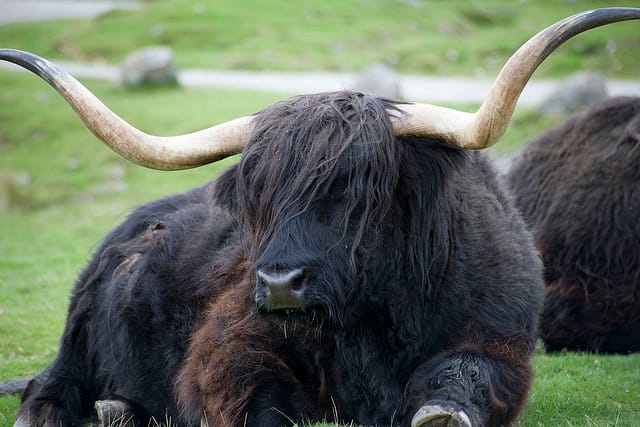Attention all nature enthusiasts! Get ready to explore the fascinating world of yaks, the mighty and majestic creatures that roam the Himalayas. These incredible animals, with their billowing manes and impressive horns, are like nature’s tough cookies, built to withstand some of the harshest conditions on Earth. Join us as we uncover the secrets of these Himalayan giants, from their incredible strength and agility to their vital role in the mountain ecosystem and the lives of the people who live alongside them.
Fun Facts About Yaks
Yaks are truly remarkable creatures! Living in the Himalayas, some of the highest mountains in the world, they don’t just survive the thin air – they thrive in it! Their lungs and respiratory system are specially adapted to handle altitudes where most of us would be gasping for air.
While sadly not as numerous as they once were in the wild, yaks are fortunately doing well domestically. They play an essential role in the lives of people living in mountain communities, providing nutritious milk and meat, warm woolly fur that’s spun into yarn, and incredible strength for transporting goods.
Here are even more fascinating yak facts:
- Expert Mountaineers: Yaks are incredibly agile and sure-footed, easily navigating treacherous mountain paths. They’re like the mountain goats’ larger, stronger cousins!
- Living Barometers: Some people believe that yaks can sense approaching storms, perhaps explaining why they’re so adept at finding shelter.
- Elusive Mountain Spirits: Wild yaks are quite shy and prefer to keep to themselves. Sadly, their numbers are dwindling, making conservation efforts crucial to protecting these majestic creatures.
- Cultural Icons: In many mountain cultures, domesticated yaks are more than just animals; they’re practically family! Adorned with colorful decorations, yaks often participate in festivals and celebrations, demonstrating the high regard and respect they receive.
- Strength in Numbers (and Muscles): Yaks are unbelievably strong. They can carry heavy loads for long distances, making them indispensable for transporting goods through challenging terrain.
What is Unique About Yaks?
Several key features make yaks stand out in the animal kingdom:
- High-Altitude Masters: Yaks can comfortably exist at altitudes where most other animals would struggle to breathe. This suggests generations of adaptation have shaped their lungs and respiratory system to thrive in thin air.
- Endurance Champions: Yaks are the ultimate mountain companions. Their strength and stamina allow them to carry heavy loads for miles across challenging terrain.
- Built-In Winter Wear: Their thick, shaggy coat isn’t just for show. It provides incredible insulation against the extreme cold and fierce winds of the mountains, acting as a natural down jacket.
- Adaptable Eaters: Yaks aren’t picky eaters, able to digest a variety of plants, including the tough and thorny ones that other animals avoid. This adaptability is critical to their survival in the harsh mountain environment.
Beyond their physical adaptations, yaks are woven into the cultural and spiritual fabric of Himalayan communities. People rely on them for transportation, their milk is incredibly nutritious, and their wool is used for clothing and blankets. They are often featured in festivals and are seen as symbols of strength, resilience, and the enduring spirit of the mountains.
How Many Stomachs Does a Yak Have?
Yaks, like cows, sheep, and goats, belong to a group of animals called “ruminants.” This means they have a unique digestive system that allows them to break down tough, fibrous plants that most other animals can’t handle. The key to this incredible digestive ability? Yaks have four different chambers in their stomachs!
Here’s how it works:
- Rumen: The first chamber acts like a giant fermentation tank, where helpful microbes begin breaking down those tough plant fibers.
- Reticulum, Omasum, Abomasum: The food then travels through the other three chambers, where further digestion takes place.
This four-chamber system is a marvel of nature, enabling yaks to thrive in environments where food is scarce. The fermentation process in their stomachs also generates heat, helping to keep them warm in cold mountain climates.
How Intelligent Are Yaks?
Don’t let their imposing size fool you; yaks possess a surprising level of intelligence. Beyond following basic commands, yaks have demonstrated the ability to learn complex skills, such as opening gates or retrieving objects. They are observant animals, constantly analyzing their surroundings and adapting to changes in their environment. This capacity for problem-solving is crucial for navigating treacherous terrain, finding food, and avoiding predators in the challenging Himalayan landscape.
While we might not see yaks solving mathematical equations, their intelligence shines through in their practical skills and remarkable adaptability. Researchers continue to study their cognitive abilities, but it’s clear that yaks are far from simple creatures.
How Fast Can a Yak Run?
While not known for their speed, yaks are no slouches when it comes to getting around. On average, a yak can comfortably reach speeds of about 25 mph (40 km/h). If threatened, they can kick it up a notch, hitting 30 mph (48 km/h). There are even anecdotal accounts of some particularly agile yaks reaching bursts of close to 40 mph (64 km/h) for short sprints.
However, yaks are built for endurance, not speed. Like marathon runners, they can maintain a steady pace over long distances, a crucial trait for navigating the steep, uneven terrain of their natural habitat. Factors like age, health, and even individual personality can influence a yak’s speed.
What Is a Fun Fact about Yaks?
Did you know that there are different nicknames for male and female yaks? Females are often called “dri” or “nak”, while males are called “dzo” or “gyak.” Also, yak milk is a nutritional powerhouse! It’s packed with protein, calcium, and vitamin A.
But here’s where things get interesting–the word “yak” has made its way into our slang vocabulary.
- Have you ever heard someone say something is “yakky”? It means something is of poor quality or just plain bad.
- Then there’s “yakking.” This slang term refers to someone who talks excessively, often about unimportant or nonsensical things.
It just goes to show that even a powerful and majestic creature like the yak can inspire some colorful additions to our language.
Why Is Yak Meat So Good?
Yak meat is becoming increasingly popular, and for good reason! It’s a healthy and flavorful alternative to beef, offering a unique taste and a range of nutritional benefits.
Here’s what makes yak meat so special:
- Lean and Protein-Rich: Yak meat is naturally leaner than beef, making it a healthier choice. It’s also an excellent source of protein, essential for building and repairing tissues.
- Packed with Nutrients: Yak meat is a good source of iron, zinc, and B vitamins, all essential for maintaining good health.
- Unique Flavor: Many describe yak meat as having a slightly sweet, almost nutty flavor with a hint of gaminess. It’s often compared to lean beef but with a richer, more complex flavor profile.
- Versatile in the Kitchen: Yak meat can be prepared in a variety of ways. It’s delicious in stews, braises, roasts, and even as ground meat.
When cooking yak meat, low and slow is the key to tenderness and flavor.
Why Are Yaks So Important?
Yaks play a vital role in the Himalayan ecosystem:
- Grassland Guardians: Their grazing habits help maintain the health and diversity of the Himalayan grasslands, preventing the overgrowth of certain plants and ensuring a balance in the ecosystem.
- Supporting Biodiversity: Healthy grasslands, in turn, support a wide array of animals, including snow leopards, Tibetan wolves, and various bird species. Yaks are essential to maintaining this delicate web of life.
For centuries, the people of the Himalayas have relied on yaks for:
- Transportation: Their strength and sure-footedness make them ideal for navigating treacherous mountain paths, carrying both goods and people.
- Nourishment: Yak milk and meat are staples in the Himalayan diet, providing essential nutrition in a challenging environment.
- Warmth and Shelter: Yak fiber is used to make warm clothing, blankets, and even tents, providing protection from the harsh elements.
Yaks hold deep cultural and spiritual significance:
- Symbols of Strength: In Tibetan Buddhism, yaks are revered as symbols of strength, resilience, and purity.
- Cultural Celebrations: They feature prominently in religious ceremonies and festivals, where offerings are made and rituals are performed in their honor.
What are the Advantages of Yaks?
Yaks offer a compelling blend of practical advantages and endearing qualities:
- Self-Sufficient Mothers: Yaks typically give birth without assistance, requiring minimal intervention from humans and making them relatively low-maintenance livestock.
- Gentle Giants: Despite their imposing size, yaks are known for their gentle and playful nature. They form strong bonds with their herd members and can even develop close relationships with humans.
- Environmental Stewards: Their grazing habits actually benefit the environment by promoting biodiversity and preventing soil erosion.
- Resourceful Providers: Yaks are truly multifaceted animals:
- Their wool is incredibly warm, durable, and moisture-wicking.
- Their milk is a highly nutritious superfood, packed with protein, calcium, and essential vitamins.
- Trainable Companions: Yaks are intelligent and eager to please, making them highly trainable for tasks such as:
- Transportation: Carrying heavy loads across challenging terrain.
- Farming: Helping with plowing and other agricultural tasks.
- Companionship: Providing companionship and even participating in therapeutic programs.
While much is known about yaks, research continues to uncover new insights into their genetics, behavior, and adaptations. Their enduring presence in the Himalayas stands as a testament to their resilience and the intricate balance of life in one of the world’s most extreme environments.
What is the Specialty of Yak Wool?
Yak wool is a highly prized fiber, renowned for its exceptional warmth, softness, and unique properties:
- Warmth Without Weight: Yak wool is warmer than sheep’s wool, thanks to its hollow fibers that trap heat more effectively.
- Surprisingly Soft: Despite its warmth, yak wool is surprisingly soft and comfortable against the skin, making it ideal for clothing and other textile applications.
- Moisture-Wicking Wonder: Yak wool is naturally breathable and wicks moisture away from the body, keeping you dry and comfortable even during strenuous activities.
- Built to Last: This durable fiber is resistant to wear and tear, meaning your favorite yak wool garments will stand the test of time.
- Sustainable and Hypoallergenic: Yak wool is a renewable resource and is naturally hypoallergenic, making it a good choice for those with sensitive skin.
From its origins in the high Himalayas to its growing popularity in the world of sustainable fashion, yak wool represents a unique blend of luxury, performance, and environmental responsibility.
- Unlocking Francis Alexander Shields’ Finance Empire: A Comprehensive Biography - July 12, 2025
- Unveiling Francis Alexander Shields: A Business Legacy - July 12, 2025
- Francis Alexander Shields’ Business Career: A Comprehensive Overview - July 12, 2025















